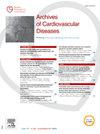高强度长时间运动对遗传性心律失常左室心肌病的影响
IF 2.3
3区 医学
Q2 CARDIAC & CARDIOVASCULAR SYSTEMS
引用次数: 0
摘要
致心律失常左室(LV)心肌病(ALVC)是一种遗传性疾病,伴有或不伴有功能障碍的广泛左室心肌纤维化,无或轻度右心室(RV)受累,有危及生命的室性心律失常(VA)的风险。虽然高强度(HI)和长时间(LD)运动已被确定为心律失常性RV心肌病(包括无症状遗传变异携带者)中RV功能障碍和VA的危险因素,但运动对ALVC疾病表型和风险的影响尚不清楚。目的研究高强度运动和低强度运动与ALVC表型发生风险及其严重程度的关系。方法采用回顾性观察研究方法,对携带常见ALVC基因(DSP、FLNC、DES、RBM20)致病变异的患者,包括无症状携带者,从7岁至遗传或疾病诊断时的身体活动情况进行访谈。HI和LD运动被定义为分别进行了至少1项强度≥6mets和≥2.5小时/周的运动。我们研究了HI和LD运动与ALVC表型发生风险及其严重程度的关系。结果128例符合条件的患者中有114例(DSP变异85例(74.6%),FLNC 22例(19.3%),DES 6例(5.3%),RBM20 1例(0.9%))。46个家庭中先证者35例(31%),亲属79例(69%)。31例(27%)在遗传诊断时没有ALVC表型。平均诊断年龄41±18岁。62例(54%)为女性。97人(85%)至少进行过一项运动,其中HI组81人(83.5%),LD组79人(81.4%)。先知者与亲属之间(74.3% vs 69.6%, P = 0.6和74.3% vs 67.1%, P = 0.4)以及诊断时ALVC表型与非ALVC表型患者之间(74.7% vs 61.3%, P = 0.2和72.3% vs 61.3%, P = 0.3)的HI和LD运动练习均无差异。诊断时的表型特征在患有和未患有HI和LD的患者之间没有差异(表1)。调整了年龄和性别的多因素分析显示,HI和LD运动与发生ALVC表型的风险增加没有显著相关(HI和LD运动的OR [95% CI]为2.15 [0.63;7.27] (P = 0.22)和1.17 [0.35];3.87] (P = 0.79)。结论在ALVC基因变异携带者中,进行HI和LD运动与诊断时ALVC表型及其严重程度的风险增加无关。本文章由计算机程序翻译,如有差异,请以英文原文为准。
Impact of high intensity and long duration exercise in genetic arrhythmogenic left ventricular cardiomyopathy
Introduction
Arrhythmogenic left ventricular (LV) cardiomyopathy (ALVC) is a genetic disease associating extensive LV myocardial fibrosis with or without dysfunction and no or mild right ventricle (RV) involvement, at risk of life-threatening ventricular arrhythmias (VA). While high intensity (HI) and long duration (LD) exercise have been identified as risk factors of RV dysfunction and VA in arrhythmogenic RV cardiomyopathy including in asymptomatic genetic variant carriers, the impact of exercise on disease phenotype and risk is not known in ALVC.
Objective
To study the relationship between practicing HI and LD exercise and the risk of developing an ALVC phenotype and its severity.
Method
In a retrospective observational study, patients with a pathogenic variant in common ALVC genes (DSP, FLNC, DES, RBM20), including asymptomatic carriers, were interviewed about their physical practice from age 7 to the time of genetic or disease diagnosis. HI and LD exercise were defined as having practiced at least 1 sport with an intensity ≥ 6 METs and ≥ 2.5 hours/week respectively. We studied the association of HI and LD exercise practice with the risk of ALVC phenotype occurrence and its severity.
Results
114 out of 128 eligible patients were included (85 (74.6%) with a DSP variant, 22 FLNC (19.3%), 6 DES (5.3%), 1 RBM20 (0.9%)). 35 were probands (31%) and 79 relatives (69%) among 46 families. 31 (27%) had no ALVC phenotype at the time of genetic diagnosis. Mean age at diagnosis was 41 ± 18. 62 (54%) patients were women. 97 (85%) had practiced at least one sport, among which 81 (83.5%) at HI and 79 (81.4%) of LD. There were no differences in HI and LD exercise practice between probands and relatives (74.3% vs 69.6%, P = 0.6 and 74.3% vs 67.1%, P = 0.4 respectively), as well as between patients with and patients without ALVC phenotype at the time of diagnosis (74.7% vs 61.3%, P = 0.2 and 72.3% vs 61.3%, P = 0.3 respectively). Phenotypic features at diagnosis did not differ between patients with and without HI and LD practice (Table 1). Multivariate analysis adjusted on age and gender showed that HI and LD exercise were not significantly associated with an increased risk of developing an ALVC phenotype (OR [95% CI] for HI and LD exercise were 2.15 [0.63; 7.27] (P = 0.22) and 1.17 [0.35; 3.87] (P = 0.79) respectively).
Conclusion
Practicing HI and LD exercise was not associated with an increased risk of developing an ALVC phenotype and its severity at the time of diagnosis in genetic ALVC variant carriers.
求助全文
通过发布文献求助,成功后即可免费获取论文全文。
去求助
来源期刊

Archives of Cardiovascular Diseases
医学-心血管系统
CiteScore
4.40
自引率
6.70%
发文量
87
审稿时长
34 days
期刊介绍:
The Journal publishes original peer-reviewed clinical and research articles, epidemiological studies, new methodological clinical approaches, review articles and editorials. Topics covered include coronary artery and valve diseases, interventional and pediatric cardiology, cardiovascular surgery, cardiomyopathy and heart failure, arrhythmias and stimulation, cardiovascular imaging, vascular medicine and hypertension, epidemiology and risk factors, and large multicenter studies. Archives of Cardiovascular Diseases also publishes abstracts of papers presented at the annual sessions of the Journées Européennes de la Société Française de Cardiologie and the guidelines edited by the French Society of Cardiology.
 求助内容:
求助内容: 应助结果提醒方式:
应助结果提醒方式:


